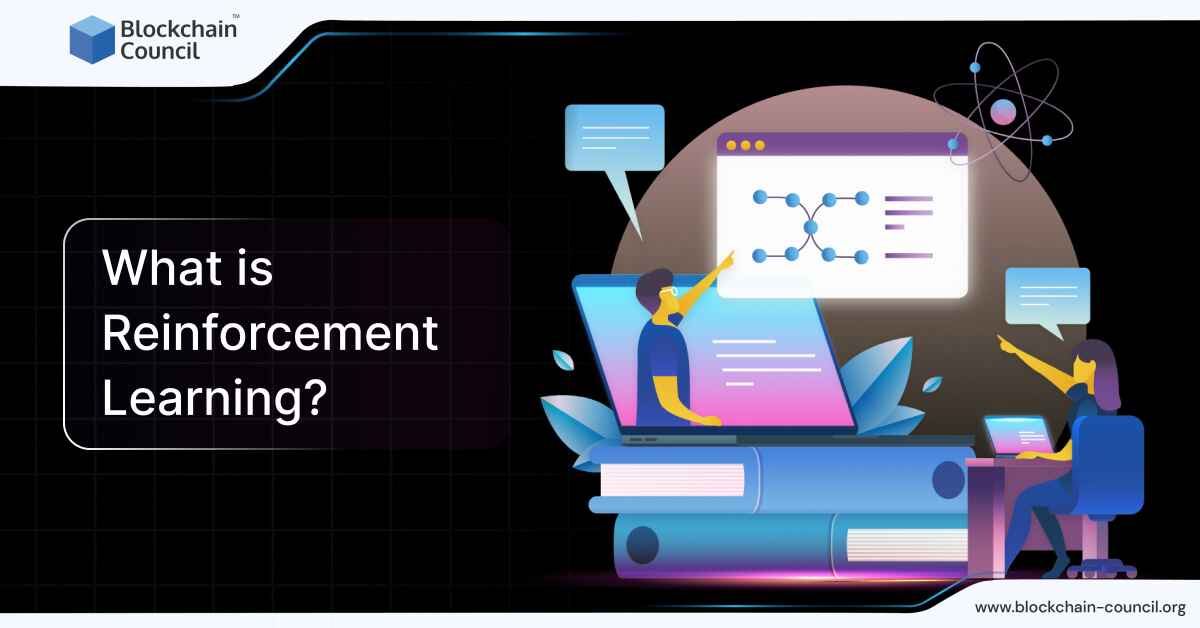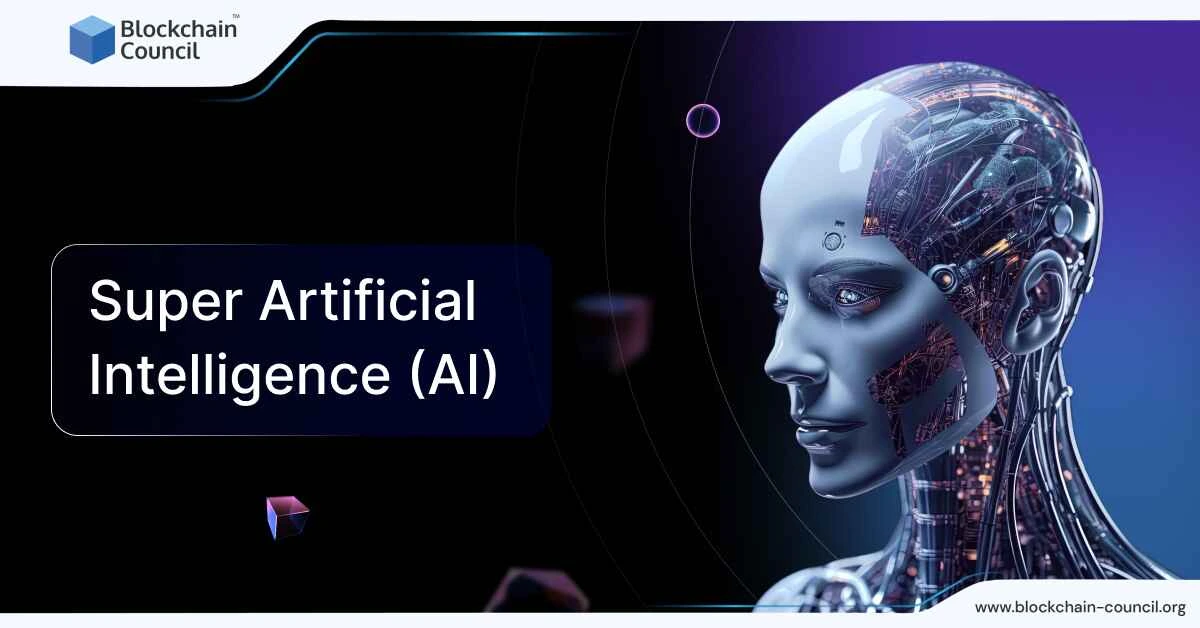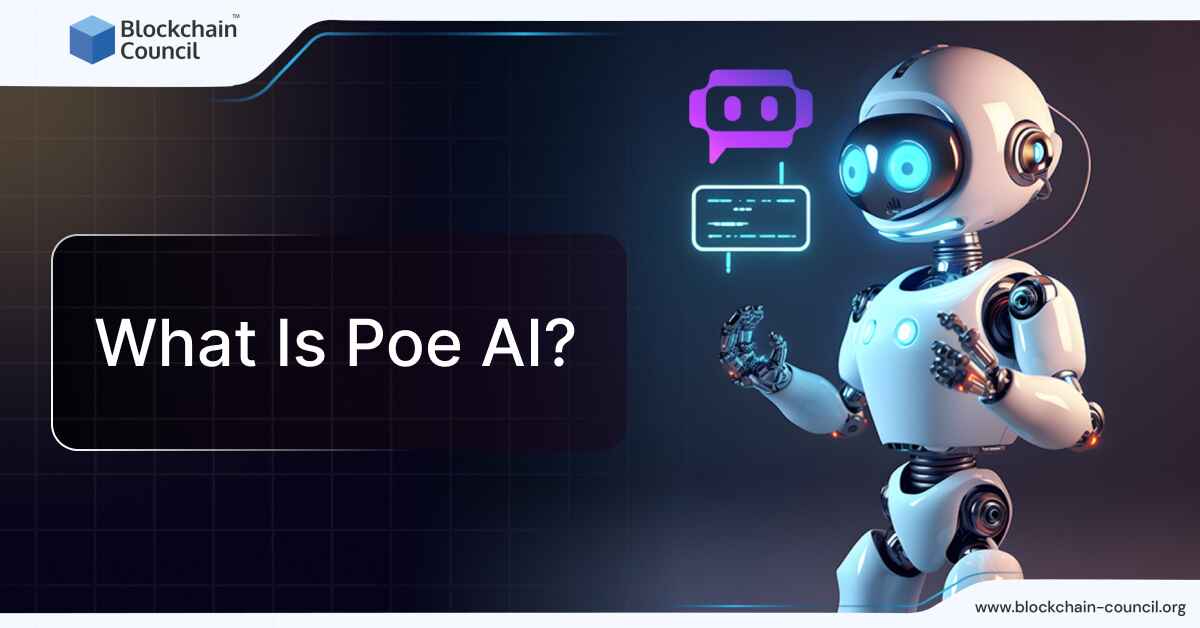
- Blockchain Council
- September 13, 2024
Summary
- Reinforcement Learning (RL) teaches computers to learn from experience, akin to human learning.
- RL involves an agent making decisions, receiving feedback (rewards or penalties), and adjusting actions to achieve goals.
- RL has diverse applications, including autonomous vehicles, stock trading algorithms, robotics, and game playing.
- RL focuses on learning optimal strategies through trial and error, solving complex problems traditional approaches can’t handle.
- Core components of RL include agents, environments, states, actions, and rewards.
- RL aims to learn policies that guide agent actions to maximize cumulative rewards over time.
- RL environments can be episodic (distinct episodes) or continuing (continuous interaction).
- The discount factor in RL influences how future rewards are valued, balancing immediate and long-term rewards.
- Different methods in RL include dynamic programming, Monte Carlo methods, and temporal difference learning.
- RL faces challenges like model complexity, data efficiency, safety, and ethics but offers opportunities for interdisciplinary collaboration and real-world applications.
Reinforcement Learning (RL) is a fascinating area of artificial intelligence that teaches computers to learn from their actions in a similar way that humans learn from experience. Unlike traditional forms of machine learning, where a model learns from a dataset provided to it beforehand, RL involves an agent that makes decisions, observes the outcomes of these decisions (rewards or penalties), and adjusts its actions based on these observations to achieve a certain goal.
RL’s applications span a wide range of fields, from autonomous vehicles navigating through traffic to algorithms trading stocks on Wall Street, robots performing complex tasks in manufacturing, and even AI playing and mastering complex games like Go and poker. As we delve into these applications, you’ll see how RL’s ability to learn optimal strategies through trial and error can solve problems that are too complex for traditional programming approaches.
This article aims to unravel the complexities of RL, guiding you through its fundamental concepts, where it’s applied, and why it’s becoming increasingly important in the modern tech landscape.
What is Reinforcement Learning?
Reinforcement Learning (RL) is a type of Machine Learning where an agent learns to make decisions by interacting with its environment. The goal is for the agent to take actions that will maximize some notion of cumulative reward. RL differs from other machine learning paradigms like supervised learning, where learning is done from a training set of labeled examples, and unsupervised learning, which deals with finding hidden patterns or intrinsic structures in input data.
Basics of Reinforcement Learning
In RL, an agent learns from the consequences of its actions, rather than from being told explicitly what to do. This process involves four main elements: an agent, a set of states, a set of actions, and rewards. The agent makes decisions, moving from one state to another, and receives rewards or penalties in response to its actions. Over time, the agent learns a policy, mapping states to the actions that maximize cumulative reward.
Reinforcement Learning (RL) vs Supervised Learning vs Unsupervised Learning
| Aspect | Reinforcement Learning (RL) | Supervised Learning | Unsupervised Learning |
| Learning Approach | Learns through interaction with an environment | Learns from labeled training data | Learns from unlabeled data |
| Feedback | Receives feedback in the form of rewards or penalties | Feedback is provided during training via labeled data | No explicit feedback, learns patterns from data alone |
| Goal | Aims to maximize cumulative reward over time | Aims to learn a mapping between inputs and outputs | Aims to find patterns or structure in data without labels |
| Task | Typically sequential decision-making problems | Classification or regression tasks | Clustering, dimensionality reduction, density estimation |
| Data Requirement | Interacts with an environment to generate data | Requires labeled data for training | Works with unlabeled data, no explicit labels provided |
| Examples | Game playing, robotics, recommendation systems | Image classification, sentiment analysis | Clustering, anomaly detection, feature learning |
Also Read: Deep Learning vs Machine Learning vs Artificial Intelligence: A Beginner’s Guide
Core Concepts of Reinforcement Learning
Reinforcement Learning (RL) is a fascinating area of study that bridges machine learning and optimal decision-making, focusing on how agents (such as robots or software entities) should take actions in environments to maximize some notion of cumulative reward. This approach is distinct from other machine learning paradigms like supervised and unsupervised learning because it emphasizes learning optimal behaviors through trial and error, without the need for labeled data or explicit correction of mistakes. Instead, it balances exploration of uncharted territory with the exploitation of current knowledge to maximize long-term benefits.
Overview of Agents, Environments, States, Actions, and Rewards
At the heart of RL are several key components: agents, environments, states, actions, and rewards. The agent is the learner or decision-maker, while the environment encompasses everything the agent interacts with. States represent the current situation or condition of the environment, actions are the choices made by the agent, and rewards are immediate feedback from the environment based on the agent’s actions. This feedback is crucial for the agent to understand which actions are beneficial and should be repeated in similar future situations.
Learning Policies through Trial and Error
RL is fundamentally about learning policies – strategies that guide an agent’s actions in various states. A policy defines the agent’s way of behaving at a given time. Learning a policy involves both exploration, to discover new strategies, and exploitation, to leverage known strategies that yield high rewards. This learning process is iterative and dynamic, adjusting as the agent gathers more information about the environment.
Episodic VS Continuing Environments
| Aspect | Episodic Environments | Continuing Environments |
| Definition | Consist of distinct episodes or episodes with terminal states | No distinct episodes; continuous interaction with the environment |
| Task Completion | Task ends after each episode | Task continues indefinitely |
| Examples | Games with levels or finite episodes | Autonomous driving, robotic control |
| Learning Dynamics | Learning occurs within each episode | Learning spans across multiple episodes |
| Goal Achievement | Goal typically involves completing an episode | Goal often involves optimizing long-term performance |
| Evaluation | Performance typically measured per episode | Performance evaluated over time |
Also Read: Top 10 Machine Learning Projects In 2024
The Role of the Discount Factor
The discount factor, denoted as γ (gamma), is a crucial concept in RL that influences how future rewards are valued. It determines the present value of future rewards, helping to balance the importance of immediate versus long-term rewards. A lower discount factor means the agent prioritizes immediate rewards more heavily, while a higher discount factor indicates a preference for future rewards. This factor is essential in calculating the return, or total accumulated reward, which an agent aims to maximize over time.
Reinforcement learning’s unique approach to learning through interaction makes it applicable to a wide range of tasks, from playing games to autonomous driving. By focusing on maximizing cumulative rewards, RL enables agents to make complex decisions in uncertain and dynamic environments, learning from experience without explicit instruction.
The combination of these core concepts forms the foundation of reinforcement learning, enabling agents to learn and adapt to achieve optimal behavior in diverse and challenging environments.
The RL Framework
Reinforcement Learning (RL) is an advanced area that combines machine learning and optimal control to teach agents how to act in environments to maximize rewards. Unlike supervised learning, RL doesn’t rely on labeled data. Instead, it focuses on learning from the outcomes of actions taken, emphasizing a balance between exploring new actions and exploiting known strategies to maximize long-term rewards.
Agent-Environment Interaction
In RL, an agent interacts with an environment in a cycle of actions, states, and rewards. At each step, the agent receives the current state from the environment, decides on an action, and receives a reward and a new state from the environment. This continuous loop is crucial for learning optimal actions to maximize cumulative rewards.
State and Action Value Functions
The “goodness” of states or actions is measured through state and action value functions. These functions estimate the expected return (cumulative reward) from a given state or after taking a certain action in a state. Understanding these value functions is key to determining the best possible actions for the agent to take.
Optimal Policies and Value Functions
The ultimate goal in RL is to find an optimal policy – a strategy that dictates the best action to take in every state to maximize the agent’s total reward over time. Optimal value functions are associated with these policies, providing a benchmark for the best expected returns from any given state or action.
RL is modeled as a Markov Decision Process (MDP), where the agent’s goal is to learn a policy that maximizes the reward function. This model assumes full observability of the current state, although in practice, agents might only partially observe the environment, necessitating adjustments in strategy.
Also Read: Top 10 Must-Have Machine Learning Skills
Methods and Approaches in Reinforcement Learning
Reinforcement Learning (RL) is a fascinating field where agents learn to make decisions to maximize rewards through interaction with their environment. Understanding the various methods and approaches used in RL is crucial for developing effective algorithms. Let’s dive into some of these methods, particularly focusing on dynamic programming, Monte Carlo methods, temporal difference learning, and distinguishing between model-based and model-free methods, as well as discussing online vs. offline modes.
Dynamic Programming and Monte Carlo Methods
Dynamic programming involves solving complex problems by breaking them down into simpler subproblems and solving these subproblems just once, storing their solutions. It’s particularly useful in RL for calculating the optimal policies and value functions when the complete model of the environment is known. Monte Carlo methods, on the other hand, rely on repeated random sampling to obtain numerical results. These methods are used to estimate the value functions and improve policies based on the average returns of episodes, without requiring a model of the environment. Monte Carlo methods are particularly useful for problems with stochastic transitions and rewards.
Temporal Difference Learning
Temporal Difference (TD) learning combines ideas from both dynamic programming and Monte Carlo methods. It allows an agent to learn directly from raw experience without a model of the environment’s dynamics. TD learning is based on the principle that estimates are updated based on other learned estimates, without waiting for a final outcome (unlike Monte Carlo methods, which wait until the end of the episode to update value estimates).
Model-Based VS Model-Free Methods in Reinforcement Learning
| Feature | Model-Based Methods | Model-Free Methods |
| Learning Approach | Learn a model of the environment’s dynamics | Directly learn the policy or value function |
| Dependency on Model | Depend on a learned or assumed model | Do not require an explicit model of the environment |
| Planning Efficiency | More efficient for planning and decision-making | Less efficient for planning, more data-driven |
| Sample Efficiency | Generally more sample-efficient | May require more samples to learn effectively |
| Exploration Strategy | May incorporate uncertainty for exploration | Exploration strategies are typically explicit |
| Scalability | May struggle with scalability to complex domains | Often more scalable to complex environments |
| Robustness | Can generalize well to similar environments | May suffer from overfitting or instability |
| Examples | Monte Carlo Tree Search, Dyna-Q | Q-Learning, SARSA, Deep Q-Networks (DQN) |
Online VS Offline (Batch) Modes
In online learning, the agent learns continuously from each new piece of information it encounters. This approach is suitable for environments that change over time, allowing the agent to adapt its strategy based on the latest data. Offline learning, or batch learning, involves training the agent on a fixed dataset collected from the environment. The agent learns a policy based on this dataset and does not update its policy until it receives a new batch of data. Offline learning is useful when the environment is static or when it’s too costly or risky to learn in real-time.
Exploration VS Exploitation Dilemma in Reinforcement Learning
In Reinforcement Learning (RL), making the right choice between exploring new possibilities and exploiting known rewards is a fundamental challenge. This balance is crucial because it affects how well and how quickly an agent learns to make decisions that yield the highest rewards over time.
The Dilemma Explained
- Exploration involves the agent trying new actions to gather more information about the environment. This is akin to venturing into unknown areas to discover potential rewards that haven’t been encountered yet.
- Exploitation, on the other hand, involves using the knowledge the agent has already acquired to make decisions that are believed to maximize rewards. It’s like revisiting a place where you’ve found rewards in the past because you know what to expect.
One of the classic examples used to illustrate this dilemma is the “multi-armed bandit problem,” where an agent has to decide which levers to pull, each with unknown probabilities of reward, to maximize its return over many trials.
Balancing the Tradeoff
Several strategies can be employed to manage this tradeoff, with the ε-greedy approach being one of the simplest yet effective methods. In this strategy, the agent mostly exploits its current knowledge to make decisions but also explores at a smaller rate determined by ε, a parameter that defines the likelihood of taking a random action. Over time, this parameter can be adjusted to reduce exploration as the agent becomes more confident in its knowledge of the environment.
The exploration vs. exploitation dilemma is central to many RL algorithms because it directly impacts the efficiency and effectiveness of learning. Too much exploration can lead to wasted efforts on less rewarding actions, while too much exploitation can cause the agent to miss out on discovering more valuable rewards. Thus, finding the right balance is key to developing proficient RL agents.
This concept is not just limited to theoretical problems but extends to real-world applications, such as choosing restaurants, investing in stocks, or navigating complex environments. In all cases, the agent (or decision-maker) must weigh the potential benefits of exploring new options against the safety of sticking with known quantities.
Latest Trends in Reinforcement Learning
In 2024, reinforcement learning (RL) is experiencing significant advancements, particularly through integration with large language models (LLMs). These developments are enhancing RL’s performance across various applications.
- ALOHA, a robot designed to learn complex tasks such as folding clothes, serves as a notable example.
- Another example is Voyager, an RL agent utilizing GPT-4 to achieve superior performance in Minecraft compared to previous systems.
- These examples illustrate the growing capacity of RL agents to handle more complex and nuanced tasks with greater efficiency and effectiveness.
- The RL community is also making strides in assessing and mitigating risks associated with RL-based decision-making in critical areas such as finance, healthcare, and agriculture.
- This focus on safety and reliability reflects a maturing field that is increasingly aware of the broader implications of its applications.
- Deep reinforcement learning (DRL) represents a powerful subset of machine learning at the confluence of deep learning and RL.
- It excels in solving problems requiring complex decision-making and predictive analysis.
- DRL algorithms like DQN, A3C, DDPG, TRPO, PPO, SAC, and TD3 demonstrate the field’s evolution towards more stable, efficient, and generalizable solutions.
- These algorithms have propelled DRL to the forefront of AI research, achieving remarkable success in various domains.
- Moreover, the exploration vs. exploitation dilemma remains a core challenge in RL.
- This involves balancing the need to act on existing knowledge to maximize rewards against exploring new actions to discover potentially better options.
- The -greedy method is a simple yet effective approach to navigate this trade-off.
- It illustrates the ongoing refinement of strategies to optimize learning and decision-making in RL systems.
Challenges and Opportunities
- Model Complexity: As RL models become more sophisticated, the computational complexity increases, presenting challenges in training and deployment.
- Data Efficiency: RL algorithms often require vast amounts of data for training, making efficiency in data use a crucial area for improvement.
- Safety and Ethics: Ensuring RL systems operate safely and ethically, particularly in real-world applications, remains a significant challenge.
- Interdisciplinary Collaboration: Opportunities abound for leveraging insights from psychology, neuroscience, and other fields to improve RL algorithms and their applicability.
Future Directions in Reinforcement Learning
- Hybrid Models: Combining RL with other machine learning paradigms, such as supervised and unsupervised learning, to create more robust and versatile systems.
- Real-World Applications: Expanding the use of RL in practical applications, from robotics and autonomous vehicles to healthcare and environmental conservation.
- Personalization and Adaptation: Developing RL systems that can adapt to individual preferences and changing environments, enhancing personalization in technologies.
- Scalability: Focusing on algorithms that can scale efficiently with the problem size and complexity, making RL applicable to a broader range of problems.
Conclusion
Reinforcement Learning represents a significant shift in how machines are taught to solve problems. It’s not just about feeding data into an algorithm but about creating a learning environment where an agent can safely experiment, make decisions, and learn from its successes and failures. This approach opens up a world of possibilities for developing systems that can improve autonomously over time, adapt to new situations, and make decisions under uncertainty.
Whether you’re a seasoned AI expert or new to the field, the exploration of Reinforcement Learning offers valuable insights into the future of intelligent systems. Its principles of learning from interaction, balancing exploration with exploitation, and striving for long-term rewards mirror the learning paths we humans often take. As RL continues to evolve, it promises to unlock new capabilities in AI, paving the way for smarter, more adaptable technologies that can better serve humanity.
Frequently Asked Questions
- What is reinforcement learning?
- Reinforcement Learning (RL) is a type of machine learning where an agent learns to make decisions by interacting with its environment.
- The goal of RL is for the agent to take actions that maximize some notion of cumulative reward.
- RL differs from other machine learning paradigms like supervised and unsupervised learning.
- RL involves learning from the consequences of actions rather than being explicitly told what to do.
- How does reinforcement learning work?
- RL involves four main elements: an agent, a set of states, a set of actions, and rewards.
- The agent makes decisions, moves from one state to another, and receives rewards or penalties based on its actions.
- Over time, the agent learns a policy, mapping states to actions that maximize cumulative reward.
- RL emphasizes learning optimal behaviors through trial and error, without the need for labeled data or explicit correction of mistakes.
- What are some applications of reinforcement learning?
- RL has diverse applications, including autonomous vehicles navigating through traffic, algorithms trading stocks on Wall Street, and robots performing complex tasks in manufacturing.
- RL is also used in AI playing and mastering complex games like Go and poker.
- It can be applied in recommendation systems, robotics, game playing, and many other fields.
- RL’s ability to learn optimal strategies through trial and error enables solving problems too complex for traditional programming approaches.
- What are the challenges and opportunities in reinforcement learning?
- Challenges in RL include model complexity, data efficiency, safety, and ethics.
- Opportunities for improvement lie in interdisciplinary collaboration and expanding real-world applications.
- RL offers the potential to develop systems that can improve autonomously over time, adapt to new situations, and make decisions under uncertainty.
- Despite challenges, RL promises to unlock new capabilities in AI, paving the way for smarter, more adaptable technologies.



































































 Guides
Guides News
News Blockchain
Blockchain Cryptocurrency
& Digital Assets
Cryptocurrency
& Digital Assets Web3
Web3 Metaverse & NFTs
Metaverse & NFTs
